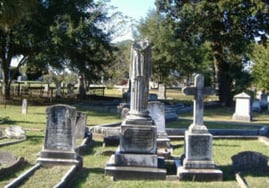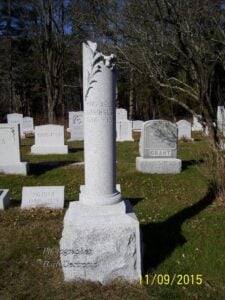 A broken column forms a monument to Adeline Wilhelmina Howell, indicating her early death at the age of 18.
A broken column forms a monument to Adeline Wilhelmina Howell, indicating her early death at the age of 18.
Gravestones have long served as the cornerstone of genealogical research. While the words they bear can be crucial sources of information about our ancestors, don’t forget to look at the symbols, too. Gravestone symbolism can point to information about your ancestors’ religious beliefs, group affiliations, life experiences, and more. Below are just a few noteworthy examples of common gravestone symbols and what they can reveal.
Religious Symbols
Religious symbols, like the Christian cross or the Jewish Star of David, can indicate the faith or religious affiliation of the interred individual. Within Christianity, different styles of crosses indicate different sects or national identities1:
- Patriarchal Cross or the Cross of Lorraine – Associated with the Eastern Orthodox Church
- Grapevine Cross – Associated with the Georgian Orthodox Church
- Crosses associated with particular countries/nationalities include the Celtic Cross, Armenian Cross, Ethiopian Cross, Macedonian Cross and Serbian Cross
- West and East Syriac Cross – Associated with Western and Eastern Syriac Christianity respectively
- Anuradhapura Cross – Associated with Christianity in Sri Lanka
These symbols can indicate the deceased’s religion, and therefore where best to search for church records.
Broken Column
Headstones, especially those carved centuries ago, deteriorate over the years, but in some cases a broken stone can be an intentional design choice. A broken column is almost  always representative of a life cut short, suggesting that the individual may have died at an early age, or before they could accomplish all of their goals in life. If you come across a broken column, it is worth considering that this person may not have lived to adulthood and may not have had any descendants, although this is not always the case. One such example can be seen on the monument to Adeline Wilhelmina Howell (pictured at top), the only daughter of Sidney S. and Adeline M. Howell, who died at the age of 18.2 Another example is the gravestone of Raffaele Gariboldi (right), who died at the age of 32 and left behind a young daughter.3
always representative of a life cut short, suggesting that the individual may have died at an early age, or before they could accomplish all of their goals in life. If you come across a broken column, it is worth considering that this person may not have lived to adulthood and may not have had any descendants, although this is not always the case. One such example can be seen on the monument to Adeline Wilhelmina Howell (pictured at top), the only daughter of Sidney S. and Adeline M. Howell, who died at the age of 18.2 Another example is the gravestone of Raffaele Gariboldi (right), who died at the age of 32 and left behind a young daughter.3
Shoes
A pair of shoes carved onto a monument usually represents a sentiment similar to a broken column, more specifically associated with the loss of a young child. Most gravestones displaying a pair of shoes memorialize the death of a child under the age of one year.4
Fraternal Organizations
Some of the more common fraternal or sororal symbols found on gravestones include:
- Freemasons
- One of the largest and most well-known fraternal organizations in the world, the number of Freemasons is estimated to be about six million worldwide. Their square and compass symbol (with and without the letter G in the center) is a strong indication of membership by the deceased.5
- The Benevolent and Protective Order of Elks
- Some lodges practice communal burial, in which deceased members are buried in a shared plot with large statues as opposed to individual grave markers.6
- The Elks also will sometimes use metal grave markers similar to those used by military-based lineage societies, like the Sons and Daughters of the American Revolution.7
- Independent Order of Odd Fellows and the Daughters of Rebekah
- The IOOF, which evolved from the Order of Odd Fellows (founded in the 1730’s in England) was founded in Baltimore, Maryland in 1819. The society, which claims 600,000 members, is most often associated with the “triple link” symbol of three chain links.8
- The Daughters of Rebekah were formed as the female auxiliary of the IOOF. Members sometimes have gravestones represented by symbols of the varying degrees of membership including a beehive, seven stars and a moon, and a lily.9
- Knights of Pythias
- This society was the first fraternal organization to receive a charter under an act of the United States Congress when it was formed in 1864. Recent estimates put their membership at about 50,000. The organization is symbolized by an inverted triangle containing red, yellow, and blue triangles with the letters F, B, and C.10
While these symbols may not immediately reveal details about the life of the deceased, they can certainly direct genealogical researchers to records they may not have considered before. For example, if your ancestor died in Massachusetts, and you find that they have a square and compass on their headstone, it would certainly be advisable to consult the records in “ Massachusetts: Grand Lodge of Masons Membership Cards, 1733-1990 ” which are available through AmericanAncestors.org.11
Thistle
As noted above, some symbols, such as the Celtic Cross, may serve as an indication of the deceased’s ancestral homeland. Another object with a similar goal is the thistle, which is often used to signify Scottish ancestry.12
Hands
The use of hands on a gravestone may indicate a number of meanings. Many of these symbols are deeply religious, and may indicate of a certain set of beliefs held by the deceased. Often, hands represent the hand of God, and the direction they point determines the meaning. For example, a hand with a finger pointing upward represents a reward of the righteous, while a finger pointing downward is a symbol of mortality and possibly a sudden death.13 Praying hands can signify the individual’s devotion to their religion, and clasped hands may represent the reunion of a couple in death.
While the words carved on gravestones are often assumed to be the most pertinent source of information for genealogists, the symbolism attached to these stones should not be overlooked. The information contained in these symbols can uncover details you may not expect, and can prompt you to take your research in an entirely new direction.
Further Reading
- Stories in Stone: A Field Guide to Cemetery Symbolism and Iconography by Douglas Keister
- Graven Images: New England Stonecarving and Its Symbols, 1650–1815 by Allen Ludwig
- Understanding Cemetery Symbols, Part I by Cathy Wallace (BillionGraves.com)
- Photo Gallery of Cemetery Symbols and Icons by Kimberly Powell (Thoughtco)
- Symbolism on Gravestones by Jessie Lie Farber (Association for Gravestone Studies)
- Gravestone Symbols and Their Hidden Meanings by Courtney Henderson (Family Tree Magazine)
- Cemetery Headstone Symbols: Finger Pointing Up by Chris Raymond (Funeral Help Center)
- Flower Symbols and Meanings on Gravestones (Stone Letters)
Notes
[1] Wallace, Cathy, “Understanding Cemetery Crosses,” BillionGraves.com, < https://blog.billiongraves.com/understanding-cemetery-crosses/ >
[2] Gravestone of Adeline Wilhelmina Howell, Magnolia Cemetery, Charleston, South Carolina, FindAGrave Memorial No. 12620171.
[3] “Raffaele Gariboldi” Barre Daily Times, Barre, VT, 14 October 1918, and Gravestone of Raffaele Gariboldi, Hope Cemetery, Barre, Vermont, FindAGrave Memorial No. 43230201.
[4] Gravestone of John Kenneth Taylor, Eldridge Cemetery, South Burlington, Vermont, FindAGrave Memorial No. 28426187, and Gravestone of Helen Darlene Starkey, Deer Creek Township Cemetery, Lafayette, Ohio, FindAGrave Memorial No. 14423683, and Gravestone of James Michael Harper, East View Cemetery, South Atlanta, Georgia, FindAGrave Memorial No. 46325894.
[5] Duncan, Malcolm C., “Duncan’s Ritual and Monitor of Freemasonry” (1866).
[6] Greenlawn Memorial Cemetery, Newport News, Virginia, Elks Memorial.
[7] “B.P.O.E,” Gravely Speaking, 18 June 2014, < https://gravelyspeaking.com/2014/06/18/b-p-o-e/ >
[8] “History of American Odd Fellowship,” Odd-fellows.org, < https://odd-fellows.org/history/wildeys-odd-fellowship/ >
[9] “Rebekahs,” Odd-fellows.org, < https://odd-fellows.org/about/rebekahs/ >
[10] “History,” pythias.org, < https://www.pythias.org/supreme/history >
[11] Massachusetts: Grand Lodge of Masons Membership Cards, 1733-1990, AmericanAncestors.org.
[12] “Flower Symbols and Meanings on Gravestones” Stone Letters, < https://stoneletters.com/blog/flower-symbols-and-meanings-on-gravestones#:~:text=Thistle,but%20has%20a%20soft%20heart >
[13] Farber, Jessie Lie, “Symbolism on Gravestones,” Association for Gravestone Studies, < https://www.gravestonestudies.org/knowledge-center/symbolism >
Share this:
About Zachary Garceau
Zachary J. Garceau is a former researcher at the New England Historic Genealogical Society. He joined the research staff after receiving a Master's degree in Historical Studies with a concentration in Public History from the University of Maryland-Baltimore County and a B.A. in history from the University of Rhode Island. He was a member of the Research Services team from 2014 to 2018, and now works as a technical writer. Zachary also works as a freelance writer, specializing in Rhode Island history, sports history, and French Canadian genealogy.View all posts by Zachary Garceau →